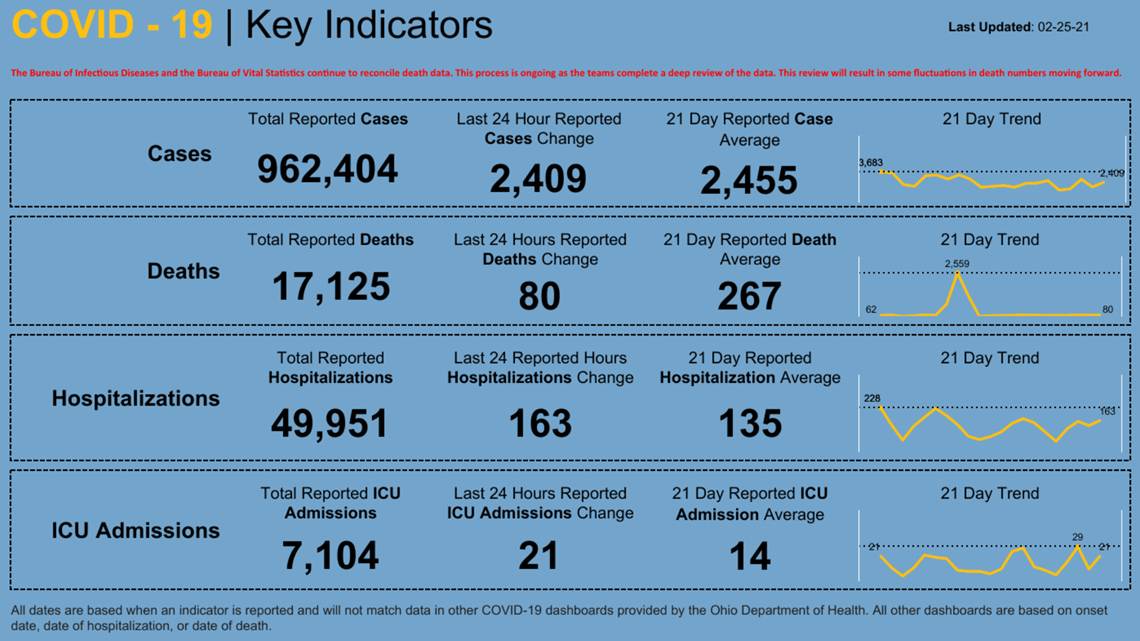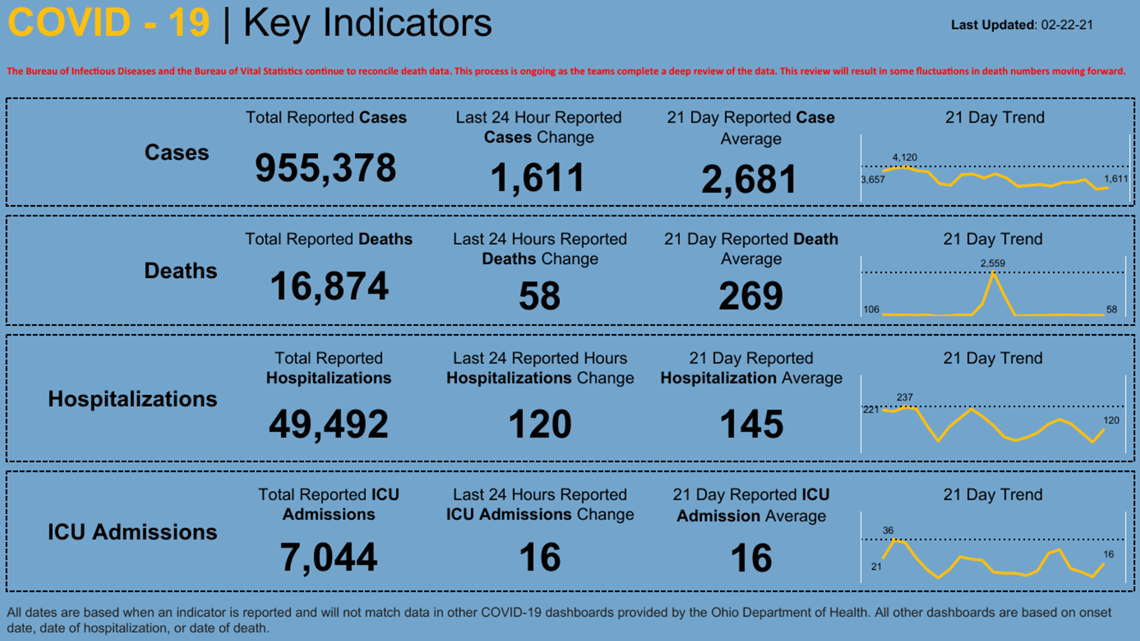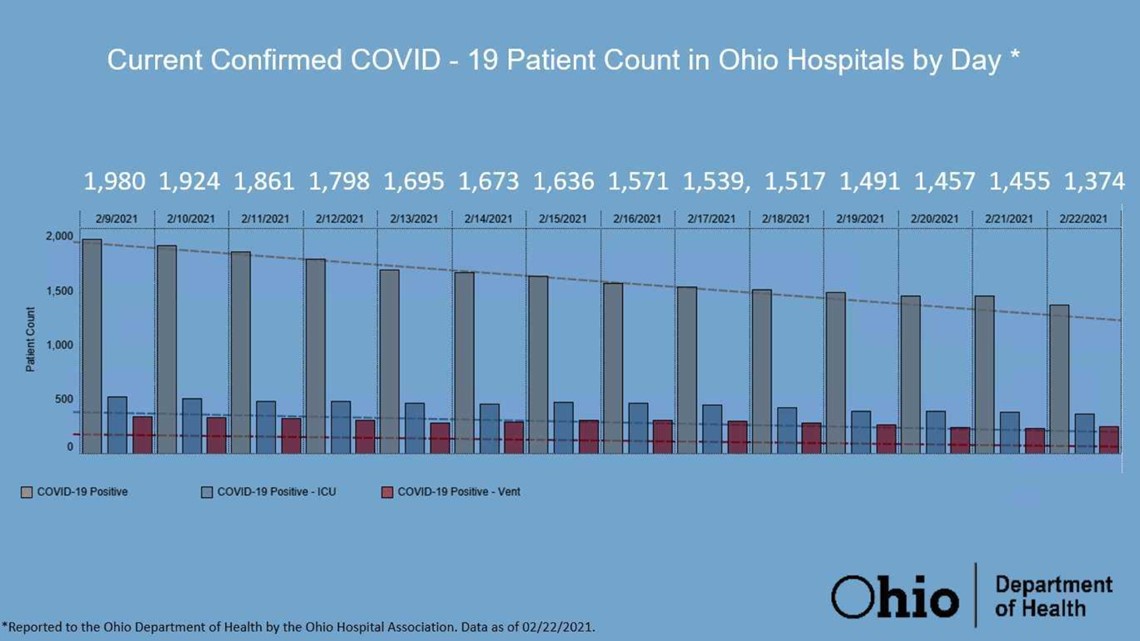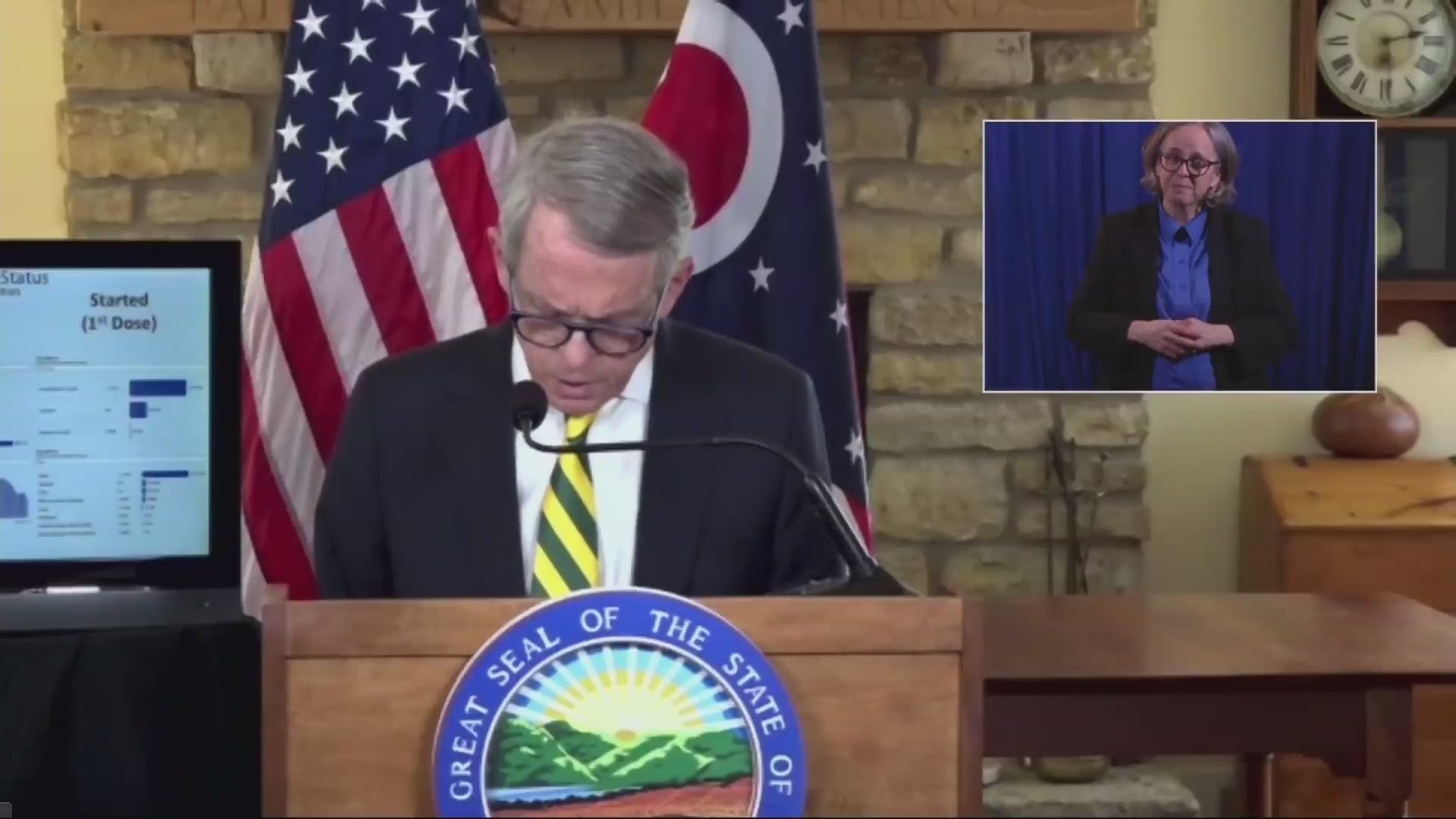COLUMBUS, Ohio — Ohio Gov. Mike DeWine held another coronavirus briefing Thursday afternoon, with a key focus on what we can expect come spring.
Though regulations will get looser, DeWine voiced concern about the COVID-19 variants popping up across the country and within the state of Ohio.
Here is a breakdown of what was discussed.
THURSDAY
SPRING EVENTS
"We know the coming months will be critical," DeWine said.
In the next week, DeWine said, his team will begin to provide guidance on events like prom, graduation, county fairs, etc. as spring fast approaches.
On Thursday, DeWine said that sporting and entertainment events will be able to reopen with 25% maximum indoor capacity and 30% maximum outdoor capacity provided they follow established precautions.
Some of those precautions include, but are not limited to:
- Mandatory mask wearing for employees/customers
- Spectator pathways that allow for social distancing
- Seating in pods of no more than six people, recommended to be of the same household.
- Seating pods must be separated by at least six feet.
General admission (lawns, standing room, infields) will be allowed, DeWine said, as long as masks are worn, and proper distancing can be marked or at least maintained.
"This is a start. If the situation improves in spring and summer, this could be expanded," DeWine said.
Guidance for proms, banquet centers, wedding receptions, fairs, festivals, and parades will be ready soon.
Though DeWine demonstrated that restrictions would begin to be pulled back, he said state leaders will move slowly as they watch what happens with the new and more contagious variants of the virus.
"The whole goal here will be for all of us to get back to where we want to be, to get back to what our life was before the pandemic. There's a bridge to that life, and we have to take the bridge," he said.
DeWine said that "bridge" is made up of two things: the vaccine and wearing a mask.
VACCINE
Next week, Ohio will have 310,000 first doses. In response, the state will be adding more vaccine provider sites -- including some Meijer and Walmart sites and more independent pharmacies. RiteAid, Kroger, CVS, Walgreens, local health departments, hospitals will also have more doses, DeWine said.
Based on information from the federal government, DeWine said, once the Johnson & Johnson vaccine is available, Ohio will have another 91,000 doses during its first week.
SCHOOLS
DeWine said that by Sunday night, all schools that signed up to receive the vaccine, besides one, will have received at least their first doses.
The governor reiterated his goal of getting all students back to in-person learning by March 1. On Thursday, he said that only 10 districts public school districts were still fully remote.
He said his team is working with those districts that won't make the March 1 deadline to ensure they get kids back into the classroom as soon as possible.
BEHAVIORAL HEALTH HOSPITALS
Beginning March 1, Ohio will lift restrictions on visitors to the state’s behavioral health hospitals. There will be certain safety measures in place to protect patients and staff, such as mask requirements, hand hygiene protocols, and time limits, DeWine said.
VETERANS HOMES
As of Thursday, admissions to Ohio's veterans' homes in Sandusky and Georgetown officially resumed.
More than 90% of veterans in these two homes accepted the vaccine. Currently, there are no positive cases at either location.
COVID-19 DATA
On Thursday, the Ohio Department of Health reported:
- 2,409 new coronavirus cases compared to the 21-day average of 2,455
- 80 coronavirus-related deaths compared to the 21-day average of 267
- 163 new coronavirus hospitalizations compared to the 21-day average of 135
- 21 new coronavirus ICU admissions compared to the 21-day average of 14


Decreasing trends continue among COVID-19 hospitalizations in Ohio, and especially for those 80+. In Dec., those 80 and older made up more than 25% of COVID-19 hospitalizations. This month, that number dropped to about 18%.
The state is also seeing a decline in COVID-19 cases among nursing home residents. Ohio had 369 new nursing home cases this past week, compared to 2,832 new cases in one week in Dec.
COMPLETE PRESS CONFERENCE
MONDAY
CATCHING UP ON DELAYED VACCINES
DeWine said that because of last week's severe winter weather, some Pfizer vaccine shipments were delivered, but all Moderna shipments were delayed.
Some providers used second doses that they had received already so they didn’t have to cancel clinics that they had scheduled. Those second doses will be backfilled, DeWine said, with the shipments they receive this week.
Additional delayed shipments of Pfizer and Moderna will arrive sometime between Monday and Wednesday.
For providers who canceled appointments, state leaders have urged them to expand their appointment schedules - including evening/weekend hours - to catch up and continue to get more vaccines out to Ohioans.
PHASE 1B VACCINATIONS
DeWine said his team is asking hospitals and doctors with access to the vaccine to proactively reach out to their patients whom they know have qualifying medical conditions under Phase 1B, so those vulnerable Ohioans can get their vaccines ASAP. Vaccine eligibility opened up to this group last week.
As a reminder, here are the medication conditions listed from the state that qualify someone for the COVID-19 vaccine:
- Sickle cell anemia
- Down syndrome
- Cystic fibrosis
- Muscular dystrophy
- Cerebral palsy
- Spina bifida
- People born with severe heart defects, requiring regular specialized medical care
- People with severe type 1 diabetes, who have been hospitalized for this in the past year
- Phenylketonuria (PKU), Tay-Sachs, and other rare, inherited metabolic disorders
- Epilepsy with continuing seizures; hydrocephaly; microcephaly, and other severe neurological disorders
- Turner syndrome, fragile X syndrome, Prader-Willi syndrome, and other severe genetic disorders
- People with severe asthma, who have been hospitalized for this in the past year
- Alpha and beta thalassemia
- Solid organ transplant candidates and recipients
The governor acknowledged that some Ohioans who do qualify for the vaccine because of these conditions that put them at a higher risk, have been denied their shot.
"That is not right. Those people should be able to get their vaccination," DeWine said last week.
In terms of age, DeWine said eligibility will stay at 65+ for a few weeks as the state works to get the majority of this group vaccinated.
Age is the top indicator of the likelihood of death from COVID-19, he said Monday.
In Ohio, 87% have been in that age group.
As the state moves forward, vaccinations will open up to ages 60+, then 55+, then 50+. Those 50+ make up 97-98% of all COVID-19 deaths in Ohio.
While no specifics were announced, DeWine said his team is also looking at certain small groups that, because of the risk of exposure, could be added to that 60+ group.
NURSING HOMES
COVID-19 cases continue to drop in Ohio's nursing homes.
Long-term care facilities reported last week 343 new cases, this is compared to the 2,832 new cases when case numbers peaked in Dec.
The positivity rate continues to drop throughout the state, and as it does, more nursing homes will be able to allow visitation.
DeWine Monday laid out the federal guidelines issued by the Centers for Medicare and Medicaid Services (CMS), explaining the three key regulations that went into effect in Sept. In order for a long-term care facility in the United States to allow visitation, it must:
- Have no new COVID-19 cases over a 14-day period
- Not currently be conducting outbreak testing
- Have a county positivity rate at less than 10%
There are exceptions, however, to these federal regulations. Even if a nursing home cannot have visitors, under CMS rules, visitation should occur in some situations.
For instance, compassionate care visits are always permitted. Compassionate care visits are special visits in which a family member or other close friend provides comfort and assistance to residents whose well-being is suffering or at risk. Compassionate care visits are not just for end-of-life situations.
Here are some examples of situations that would qualify for compassionate care visitation:
- A resident who was living with family before and was recently admitted to the facility is struggling to adjust to the change in environment.
- A resident is grieving after the loss of a close friend or family member.
- A resident who needs encouragement from a loved one to eat or drink is experiencing weight loss or dehydration because they are no longer having contact with that particular family member.
- A resident's dementia has dramatically progressed.
- During window visits, family members notice a difference in appearance, grooming or cognitive ability.
DeWine said that there have been reports of families being denied compassionate care visits when they are necessary. If this is the case, and you need help, call 1-800-282-1206.
The governor sent a letter Monday to nursing homes in the state, reminding them of their responsibility to allow for those visits. In that same letter, he told each facility to check its county's positivity rate each week to determine visitation status.
Ohio’s facilities are required to report weekly and update the state's visitation dashboard to indicate if visitation is allowed at their facility. Families can access the visitation dashboard online by clicking here.
In terms of the state's group homes for adults with disabilities, DeWine said information would be available in the next few days.
SPORTS
DeWine said that an announcement regarding sports this spring will be coming on Thursday, however, he did provide a bit of insight into what Ohioans can expect.
The state will likely allow fans in the stand at outdoor games this spring, but at 30% capacity, with the caveat that there must be adequate distancing and mask use.
DeWine said that he has already had extensive conversations with the state's Major League Baseball teams, and a Zoom call is scheduled for later this week with the minor league teams.
DeWine said his teams believe that 30% is a good place to start for outdoor events, especially as more Ohioans get vaccinated as long as safety measures are in place.
The concern is, DeWine said, that more contagious variants of COVID-19 are now in Ohio, and medical experts believe one of them will become the more dominant strain by the end of March.
In terms of indoor events, DeWine said his team is evaluating the specifics.
DeWine said he was "very optimistic" about the summer, however, saying he believes things will be "a lot better."
COVID-19 TOWN HALLS
Ohio Department of Aging Direct Ursel McElroy announced last week a series of virtual town hall sessions aimed at educating the public about COVID-19 and the current vaccines.
McElroy said the goal is to empower community leaders and members so they can incorporate correct information and effective strategies into their local vaccine plans.
Monday marks the first at 6:30 p.m., as health leaders and members of the African American community work to inform Ohioans about the vaccine.
Here are the upcoming town hall dates:
- Monday, Feb. 22, 6:30 p.m. – African American Ohioans
- Tuesday, Feb. 23, 6:30 p.m. – Hispanic/Latino Ohioans
- Monday, March 1, 6:30 p.m. – Asian American and Pacific Islander Ohioans
- Tuesday, March 2, 6:30 p.m. – Rural Ohioans
COVID-19 DATA
On Monday, the Ohio Department of Health (ODH) reported:
- 1,611 new cases compared to the 21-day average of 2,681
- 58 new deaths compared to the 21-day average of 269
- 120 new hospitalizations compared to the 21-day average of 145
- 16 ICU admissions, which matches the 21-day average


Hospitalizations continue to drop in the state.
On Monday, there was a total of 1,374 COVID-19-positive patients in Ohio's hospitals.


For more information the state's pandemic response plan, click here.

